Experimental and Numerical Investigations into the Failure Mechanisms of TRIP700 Steel Sheets
Abstract
:1. Introduction
2. Experimental Procedure
2.1. Material
2.2. Nakajima Punch Stretching Test
2.3. Cross-Die Test
3. Numerical Procedure
3.1. Failure Criteria
- As the experimental observations in sheet metals [19] show that the fracture plane inclined towards the direction that contains maximum shear stress, a shear failure model was used. Tresca criterion predicts the onset of necking, based on a macroscopic function that describes damage accumulation [20] (Equation (1)).
- Situ et al. [21,22] proposed a localized necking model according to a physical viewpoint. In this criterion, when a critical element exhibits an inflection in its major strain rate history, the localized necking initiates. This inflection corresponds to a maximum in the major strain acceleration (Equation (2)).
- In the other physical criterion, which was suggested by Martínez-Donaire et al. [23], the influence of localized necking zone on the adjacent elements is considered. According to this theory, the strain rate of the adjacent elements to the necking zone is gradually reduced as the strain rate evolution ceases (Equation (3)). In other words, these elements reach a constant level of strain or even undergo some elastic unloading before the fracture initiates, i.e., the deformation is only accompanied by elements in the necking zone.
3.2. Numerical Simulation
3.2.1. Plasticity
- Plane stress conditions, i.e., σ3 = 0.
- Plastic incompressibility during deformation, i.e., dσ1 + dσ2 + dσ3 = 0.
- Associated flow rules,
- An equivalent strain function,
- An assumption of a linear proportional strain path, i.e., .
- Voce hardening law:
3.2.2. Finite Element Method
4. Results and Discussion
4.1. Nakajima Punch Stretching Tests
4.2. Cross-Die Deep Drawing Tests
5. Conclusions
Author Contributions
Funding
Acknowledgements
Conflicts of Interest
Nomenclature
| A, B, C | strain hardening parameters, various dimensions |
| E | experimental results, in this study the results of equivalent strains |
| F, G, H | parameters of Hill 1948 criterion |
| anisotropic coefficients at from the rolling direction, dimensionless | |
| anisotropic yield stress ratio, dimensionless, | |
| P | predicted results, in this study the results of equivalent strains |
| effective or equivalent plastic strain, dimensionless | |
| logarithmic strain components, dimensionless | |
| strain path, dimensionless, | |
| effective or equivalent stress, MPa | |
| cauchy stress components, MPa | |
| yield stress, MPa | |
| maximum shear stress, MPa |
References
- Tamura, I. Deformation-induced martensitic transformation and transformation-induced plasticity in steels. Met. Sci. 1982, 16, 245–253. [Google Scholar] [CrossRef]
- Fischer, F.-D.; Reisner, G.; Werner, E.; Tanaka, K.; Cailletaud, G.; Antretter, T. A new view on transformation induced plasticity (TRIP). Int. J. Plast. 2000, 16, 723–748. [Google Scholar] [CrossRef]
- Ramazani, A.; Bruehl, S.; Gerber, T.; Bleck, W.; Prahl, U. Quantification of bake hardening effect in DP600 and TRIP700 steels. Mater. Des. 2014, 57, 479–486. [Google Scholar] [CrossRef]
- Luo, H.; Dong, H. New ultrahigh-strength Mn-alloyed TRIP steels with improved formability manufactured by intercritical annealing. Mater. Sci. Eng. A 2015, 626, 207–212. [Google Scholar] [CrossRef]
- Ramazani, A.; Quade, H.; Abbasi, M.; Prahl, U. The effect of martensite banding on the mechanical properties and formability of TRIP steels. Mater. Sci. Eng. A 2016, 651, 160–164. [Google Scholar] [CrossRef]
- Goodwin, G.M. Application of strain analysis to sheet metal forming problems in the press shop. SAE Trans. 1968, 77, 380–387. [Google Scholar]
- Keeler, S.P. Circular grid system—A valuable aid for evaluating sheet metal formability. SAE Trans. 1968, 77, 371–379. [Google Scholar]
- Marciniak, Z.; Kuczyński, K.; Pokora, T. Influence of the plastic properties of a material on the forming limit diagram for sheet metal in tension. Int. J. Mech. Sci. 1973, 15, 789–800. [Google Scholar] [CrossRef]
- Tvergaard, V.; Needleman, A. Analysis of the cup-cone fracture in a round tensile bar. Acta Metall. 1984, 32, 157–169. [Google Scholar] [CrossRef]
- Choi, K.S.; Liu, W.N.; Sun, X.; Khaleel, M.A. Microstructure-based constitutive modeling of TRIP steel: Prediction of ductility and failure modes under different loading conditions. Acta Mater. 2009, 57, 2592–2604. [Google Scholar] [CrossRef]
- Uthaisangsuk, V.; Prahl, U.; Bleck, W. Modelling of damage and failure in multiphase high strength DP and TRIP steels. Eng. Fract. Mech. 2011, 78, 469–486. [Google Scholar] [CrossRef]
- Panich, S.; Barlat, F.; Uthaisangsuk, V.; Suranuntchai, S.; Jirathearanat, S. Experimental and theoretical formability analysis using strain and stress based forming limit diagram for advanced high strength steels. Mater. Des. 2013, 51, 756–766. [Google Scholar] [CrossRef]
- Ramazani, A.; Abbasi, M.; Prahl, U.; Bleck, W. Failure analysis of DP600 steel during the cross-die test. Comput. Mater. Sci. 2012, 64, 101–105. [Google Scholar] [CrossRef]
- Bhargava, M.; Tewari, A.; Mishra, S.K. Forming limit diagram of Advanced High Strength Steels (AHSS) based on strain-path diagram. Mater. Des. 2015, 85, 149–155. [Google Scholar] [CrossRef]
- Paul, S.K. Prediction of complete forming limit diagram from tensile properties of various steel sheets by a nonlinear regression based approach. J. Manuf. Process. 2016, 23, 192–200. [Google Scholar] [CrossRef]
- Lingbeek, R.; Meinders, T.; Rietman, A. Tool and blank interaction in the cross-die forming process. Int. J. Mater. Form. 2008, 1, 161–164. [Google Scholar] [CrossRef]
- Niazi, M.S.; Wisselink, H.; Meinders, T.; Huétink, J. Failure predictions for DP steel cross-die test using anisotropic damage. Int. J. Damage Mech. 2012, 21, 713–754. [Google Scholar] [CrossRef]
- Bleck, W.; Blumbach, M. Laser-Aided Flow Curve Determination in Hydraulic Bulging. Steel Res. Int. 2005, 76, 125–130. [Google Scholar] [CrossRef]
- Bressan, J.; Williams, J. The use of a shear instability criterion to predict local necking in sheet metal deformation. Int. J. Mech. Sci. 1983, 25, 155–168. [Google Scholar] [CrossRef]
- Tresca, H. Mémoire sur l’écoulement des corps solides soumis à de fortes pressions. Comptes Rendus Hébdom. Acad. Sci. Paris 1864, 59, 754–758. [Google Scholar]
- Situ, Q.; Jain, M.; Metzger, D. Determination of forming limit diagrams of sheet materials with a hybrid experimental–numerical approach. Int. J. Mech. Sci. 2011, 53, 707–719. [Google Scholar] [CrossRef]
- Situ, Q.; Jain, M.K.; Bruhis, M. A suitable criterion for precise determination of incipient necking in sheet materials. Proc. Mater. Sci. Forum 2006, 519, 111–116. [Google Scholar] [CrossRef]
- Martínez-Donaire, A.; García-Lomas, F.; Vallellano, C. New approaches to detect the onset of localised necking in sheets under through-thickness strain gradients. Mater. Des. 2014, 57, 135–145. [Google Scholar] [CrossRef]
- Hill, R. A theory of the yielding and plastic flow of anisotropic metals. Proc. R. Soc. Lond. A Math. Phys. Eng. Sci. 1948, 193, 281–297. [Google Scholar] [CrossRef]
- Ghosh, A.K. A method for determining the coefficient of friction in punch stretching of sheet metals. Int. J. Mech. Sci. 1977, 19, 457–470. [Google Scholar] [CrossRef]
- Bleck, W.; Deng, Z.; Papamantellos, K.; Gusek, C.O. A comparative study of the forming-limit diagram models for sheet steels. J. Mater. Process. Technol. 1998, 83, 223–230. [Google Scholar] [CrossRef]
- Anderson, D. Application and Repairability of Advanced High-Strength Steels; American Iron and Steel Institute: Charlotte, NC, USA, 2008. [Google Scholar]
- Quade, H. Mechanical Properties, Damage Behaviour and Retained Austenite Stability in Low-Alloyed Trip Steels—Experimental & Numerical Analyses (Berichte aus dem Institut fur Eisenhuttenkunde); Shaker Verlag GmbH: Herzogenrath, Germany, 2014; pp. 114–116. [Google Scholar]
- Savic, V.; Hector, L., Jr.; Fekete, J. Digital image correlation study of plastic deformation and fracture in fully martensitic steels. Exp. Mech. 2010, 50, 99–110. [Google Scholar] [CrossRef]
- Kang, J.; Wilkinson, D.S.; Bruhis, M.; Jain, M.; Wu, P.D.; Embury, J.D.; Mishra, R.K.; Sachdev, A.K. Shear localization and damage in AA5754 aluminum alloy sheets. J. Mater. Eng. Perform. 2008, 17, 395–401. [Google Scholar] [CrossRef]
- Habibi, N.; Zarei-Hanzaki, A.; Abedi, H.-R. An investigation into the fracture mechanisms of twinning-induced-plasticity steel sheets under various strain paths. J. Mater. Process. Technol. 2015, 224, 102–116. [Google Scholar] [CrossRef]
- Situ, Q.; Jain, M.K.; Bruhis, M. Further experimental verification of a proposed localized necking criterion. AIP Conf. Proc. 2007, 908, 907–912. [Google Scholar]
- Teirlinck, D.; Zok, F.; Embury, J.; Ashby, M. Fracture mechanism maps in stress space. Acta Metall. 1988, 36, 1213–1228. [Google Scholar] [CrossRef]
- Situ, Q.; Bruhis, M.; Jain, M. Obtaining Formability Characteristics of Automotive Materials Using On-line Strain Imaging System. AIP Conf. Proc. 2005, 778, 131–135. [Google Scholar]
- Habibi, N.; Ramazani, A.; Sundararaghavan, V.; Prahl, U. Failure predictions of DP600 steel sheets using various uncoupled fracture criteria. Eng. Fract. Mech. 2018, 190, 367–381. [Google Scholar] [CrossRef]

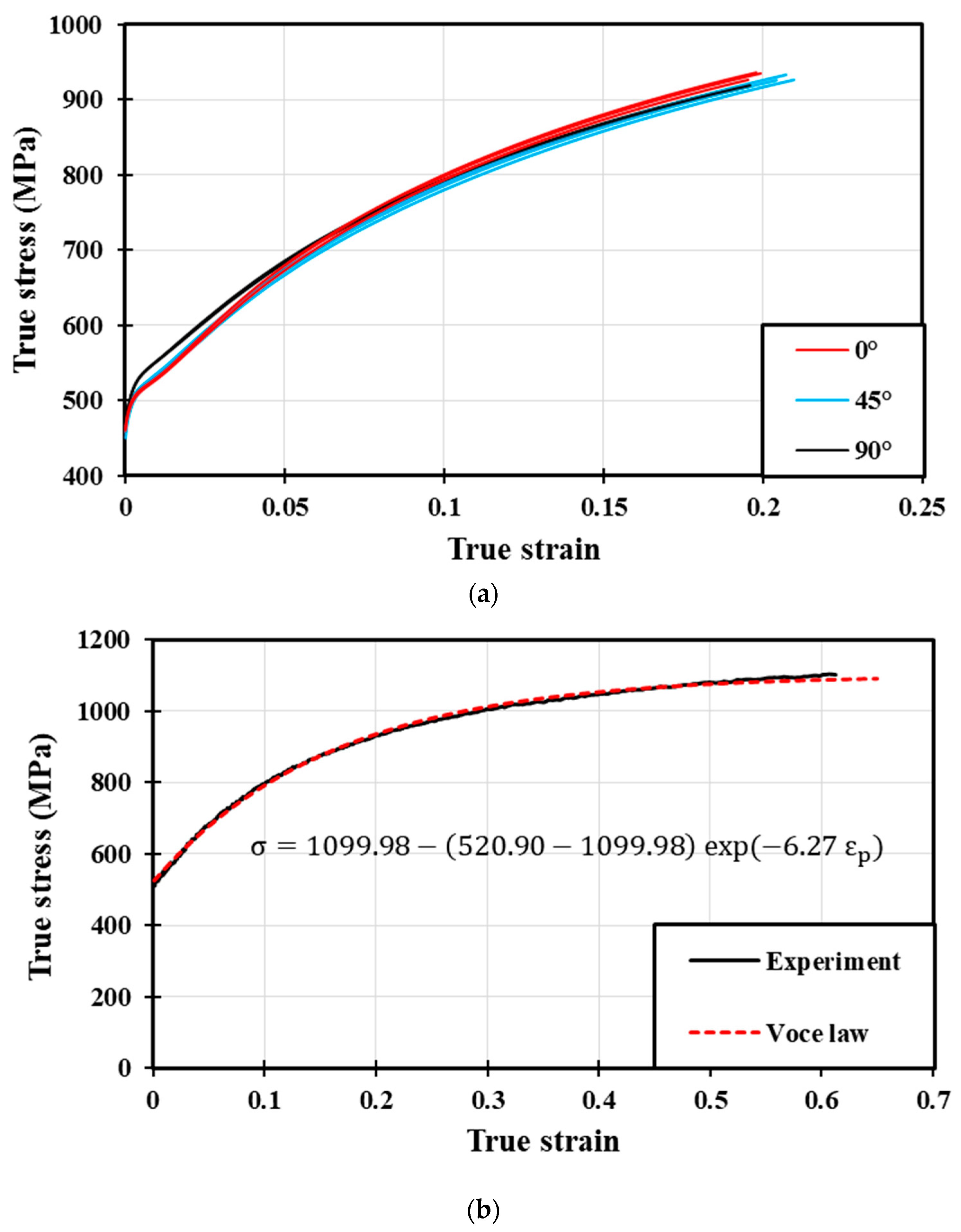
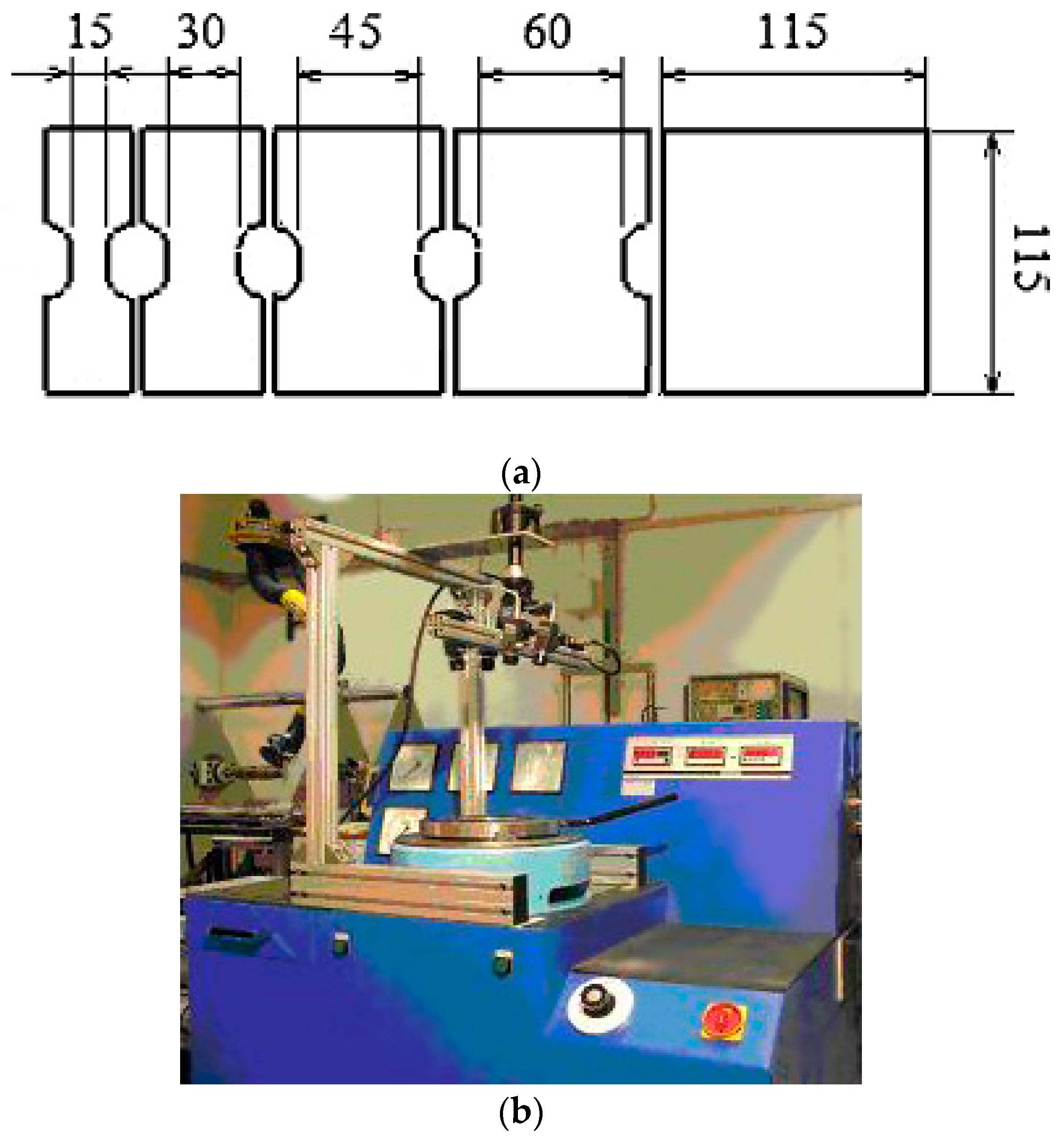

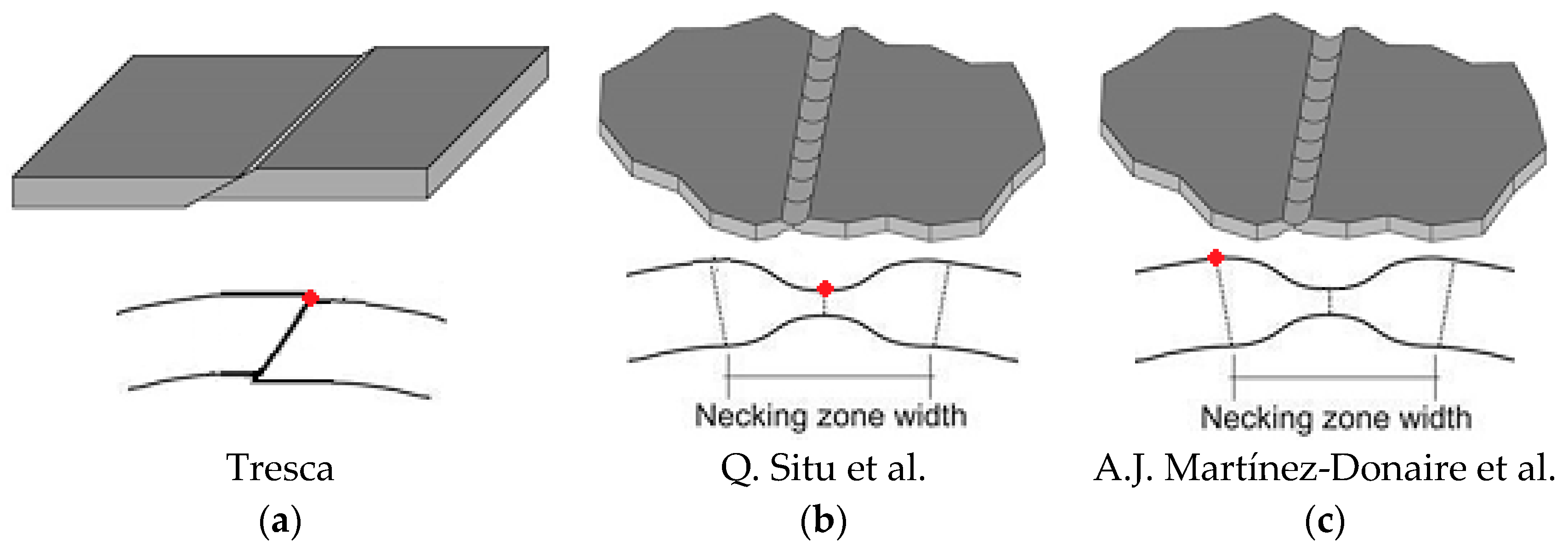
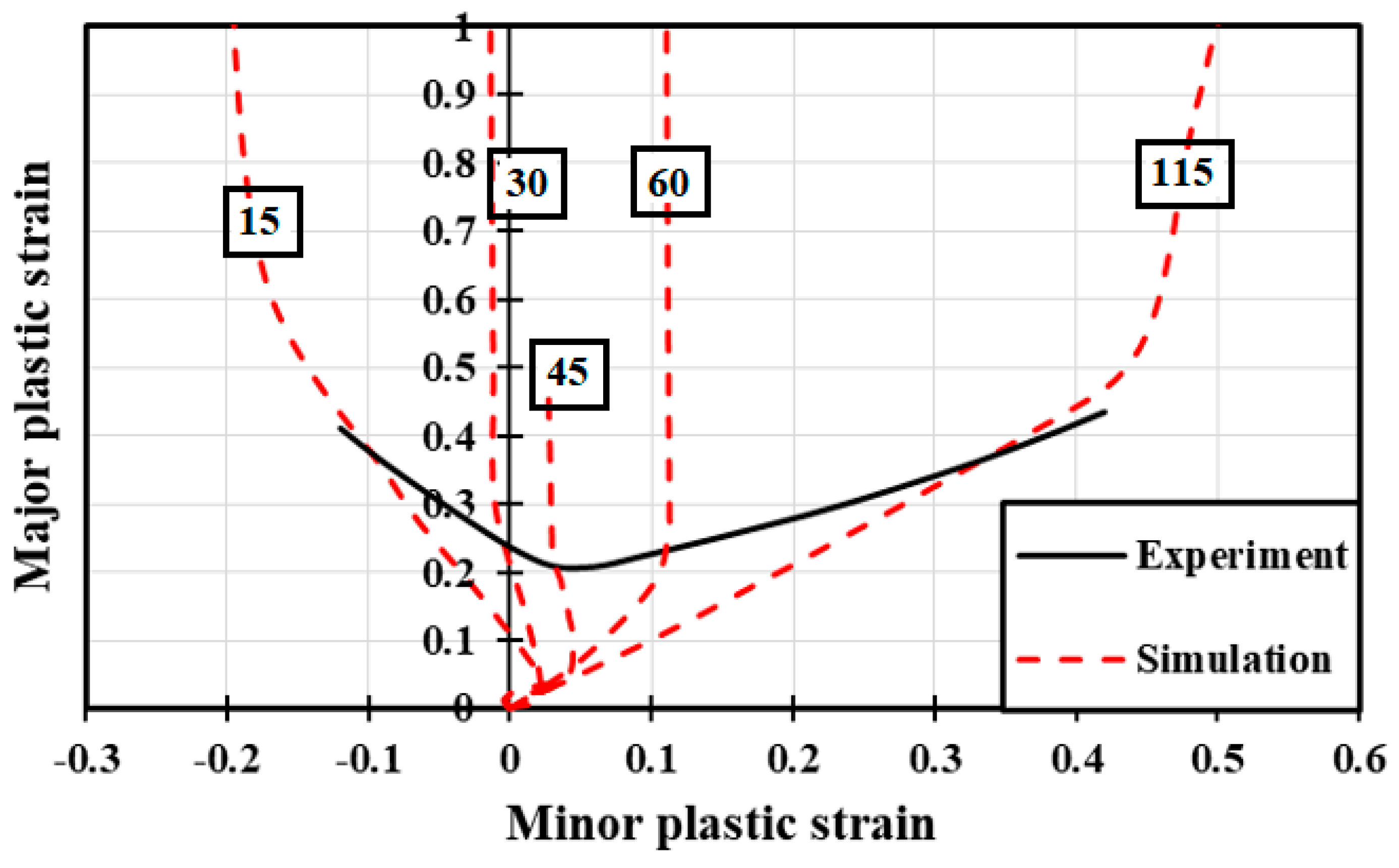
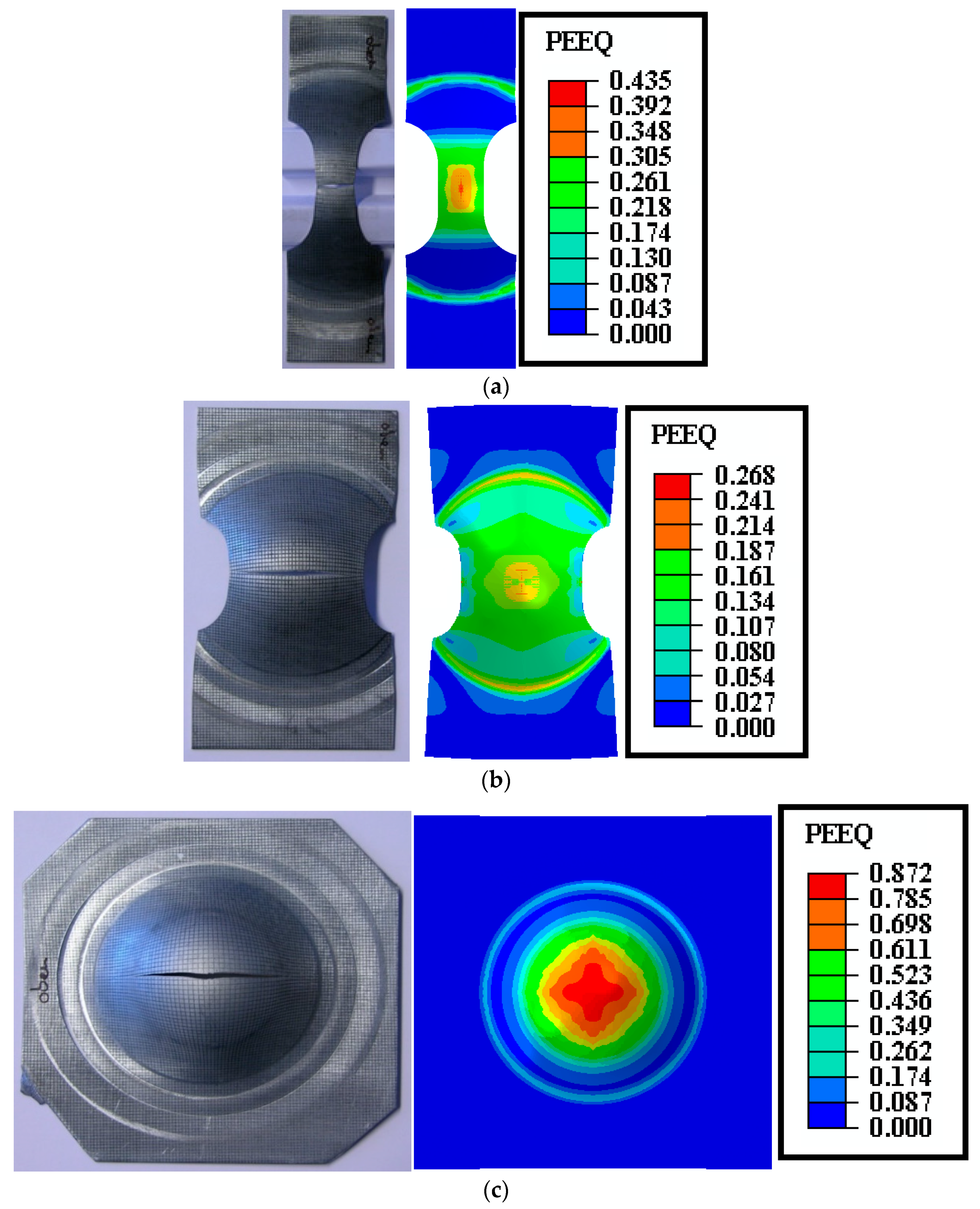
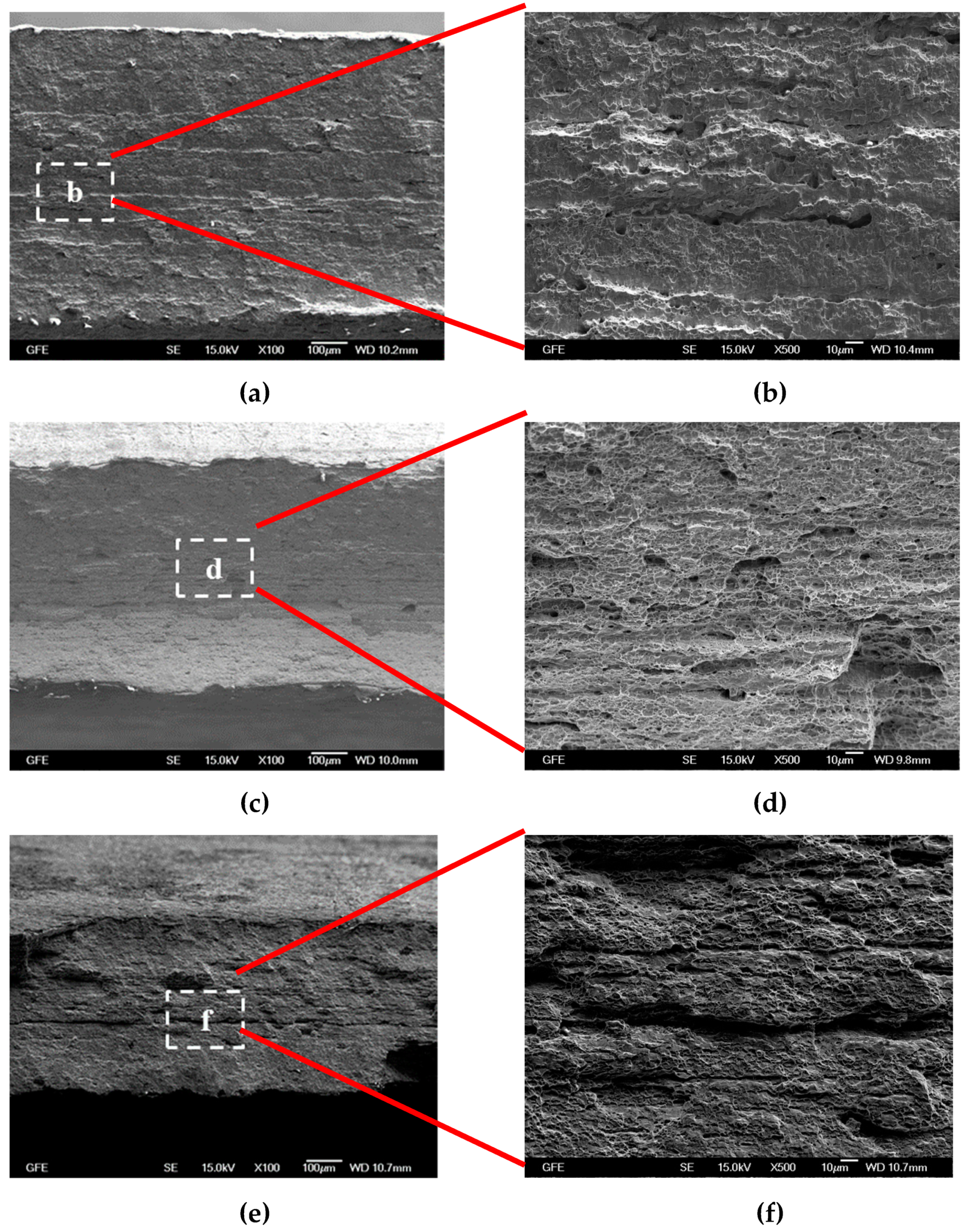

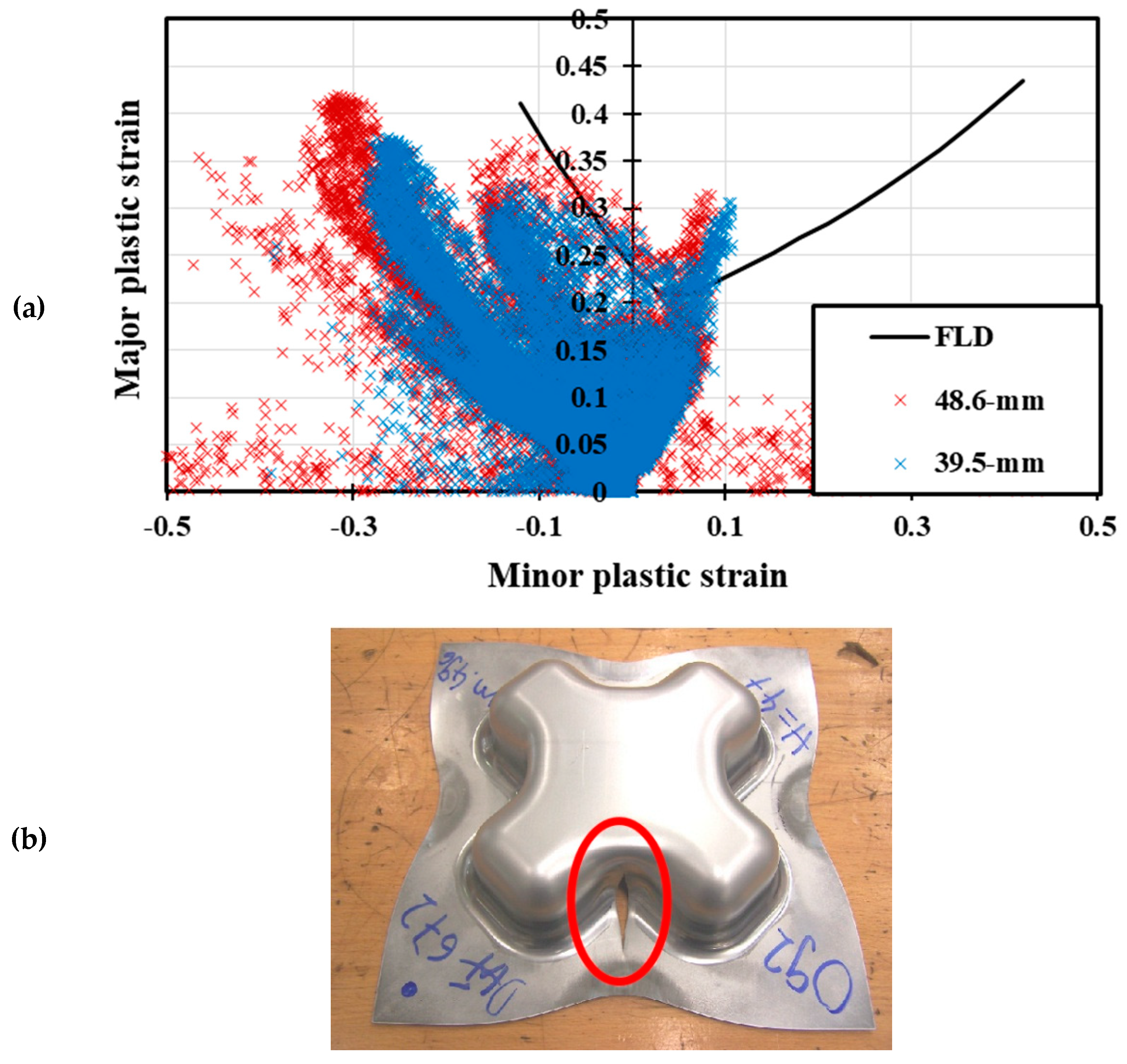
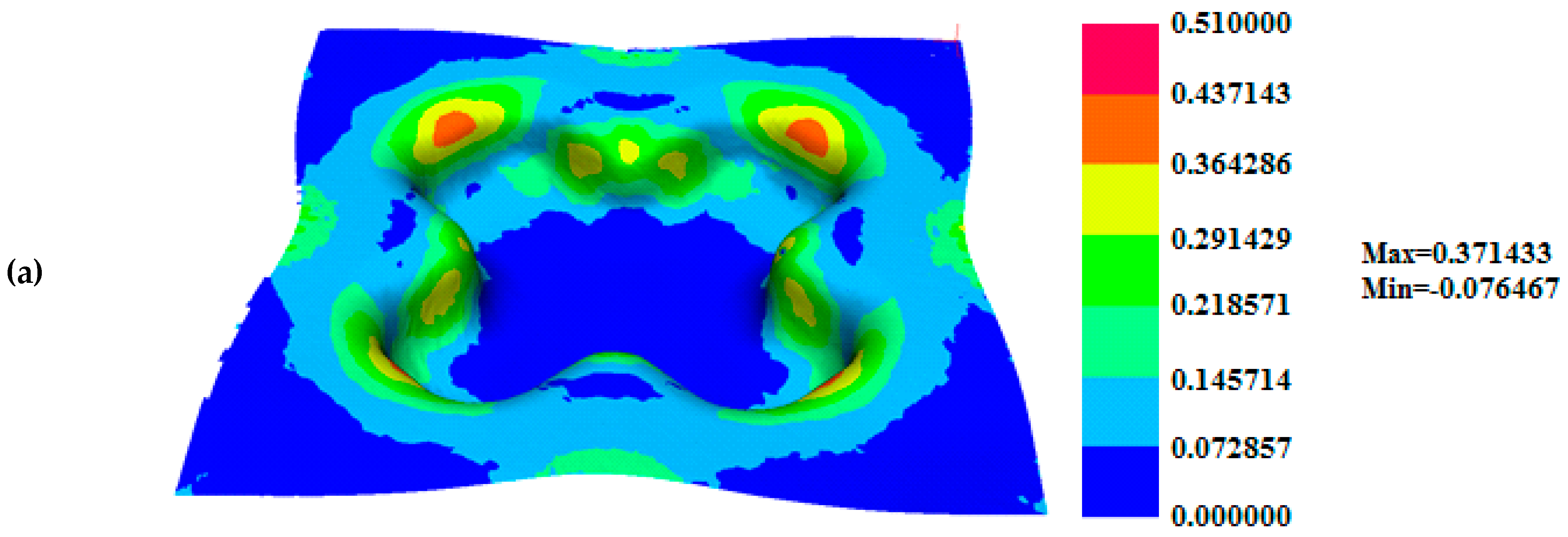
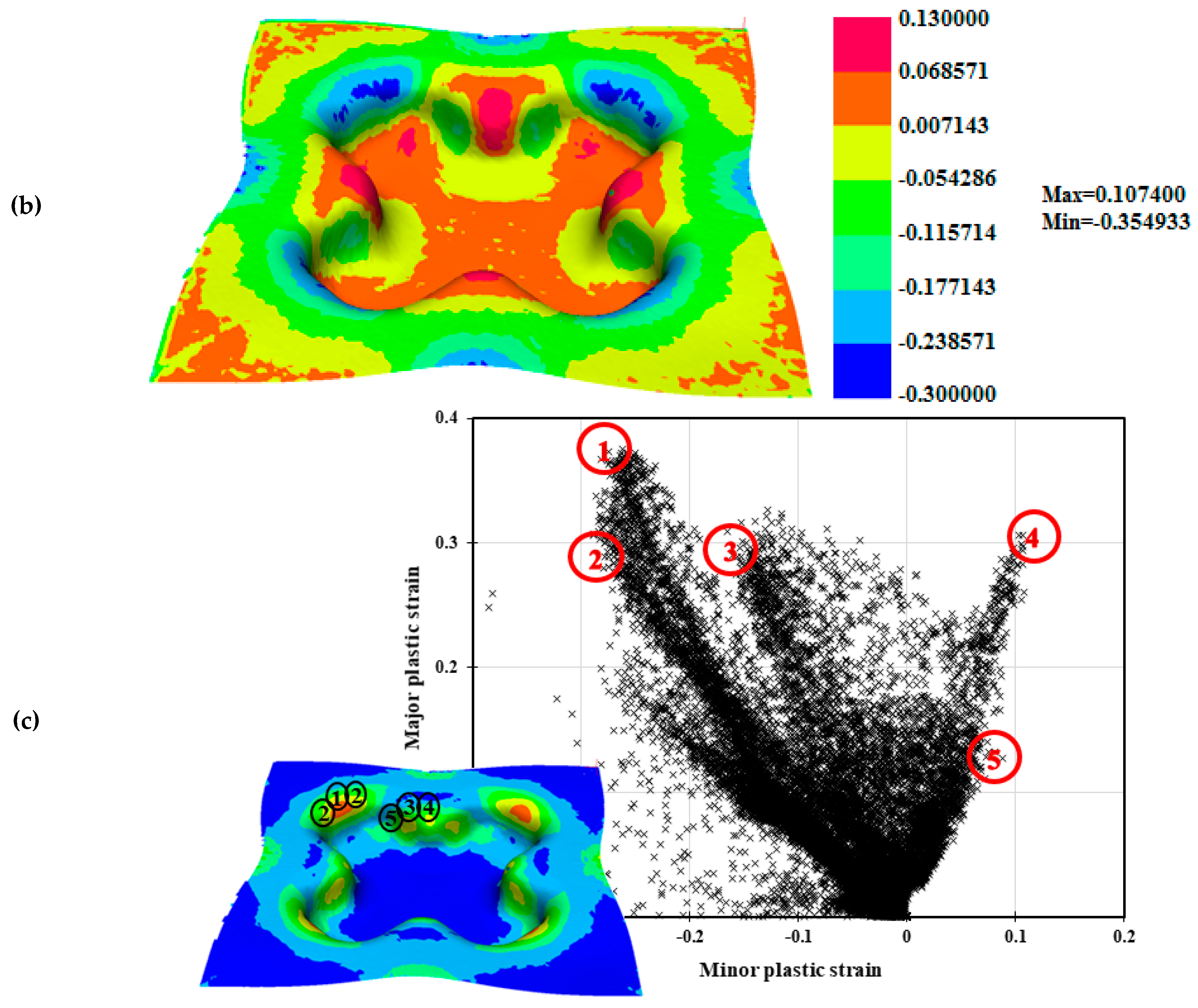


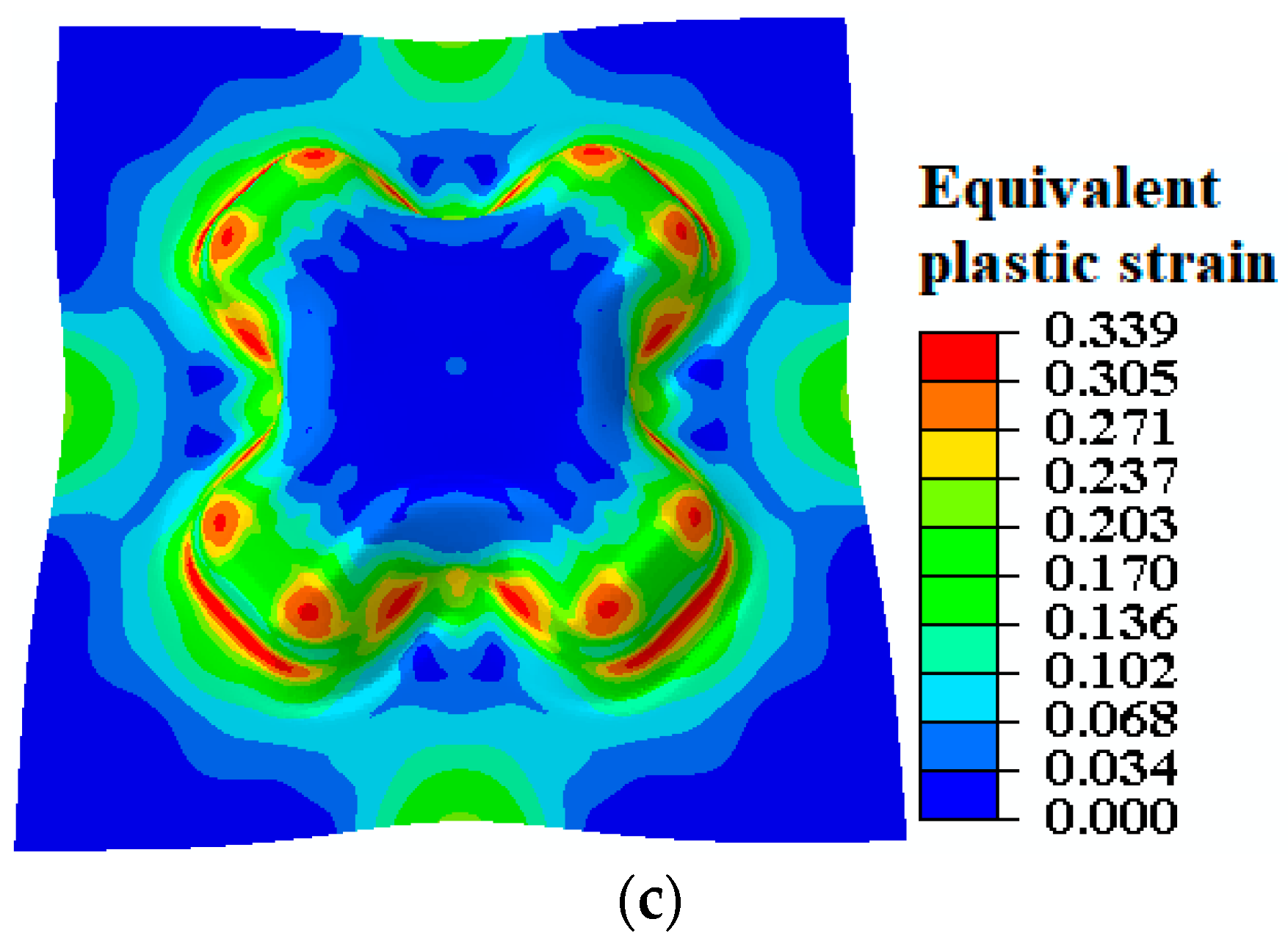
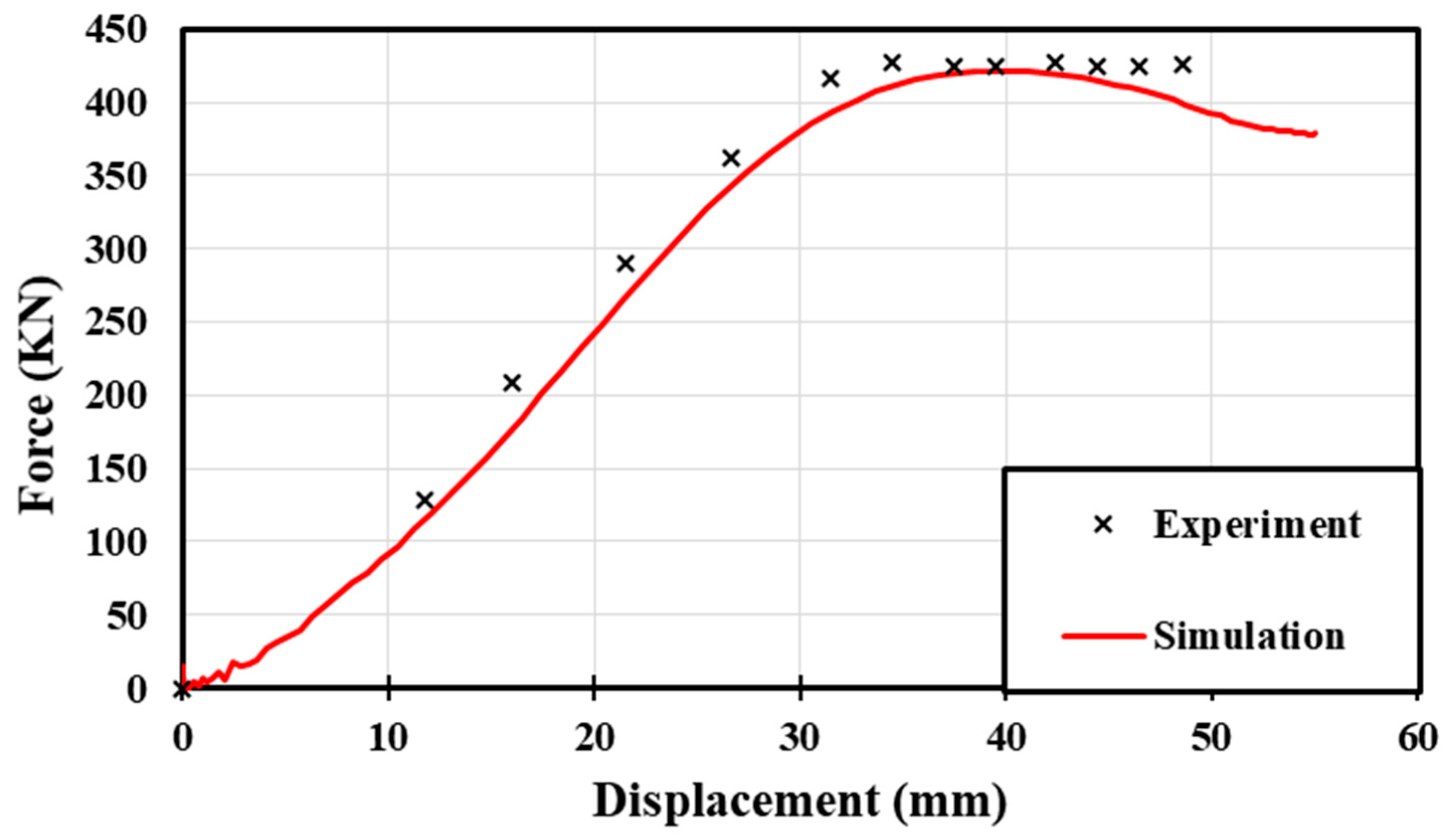
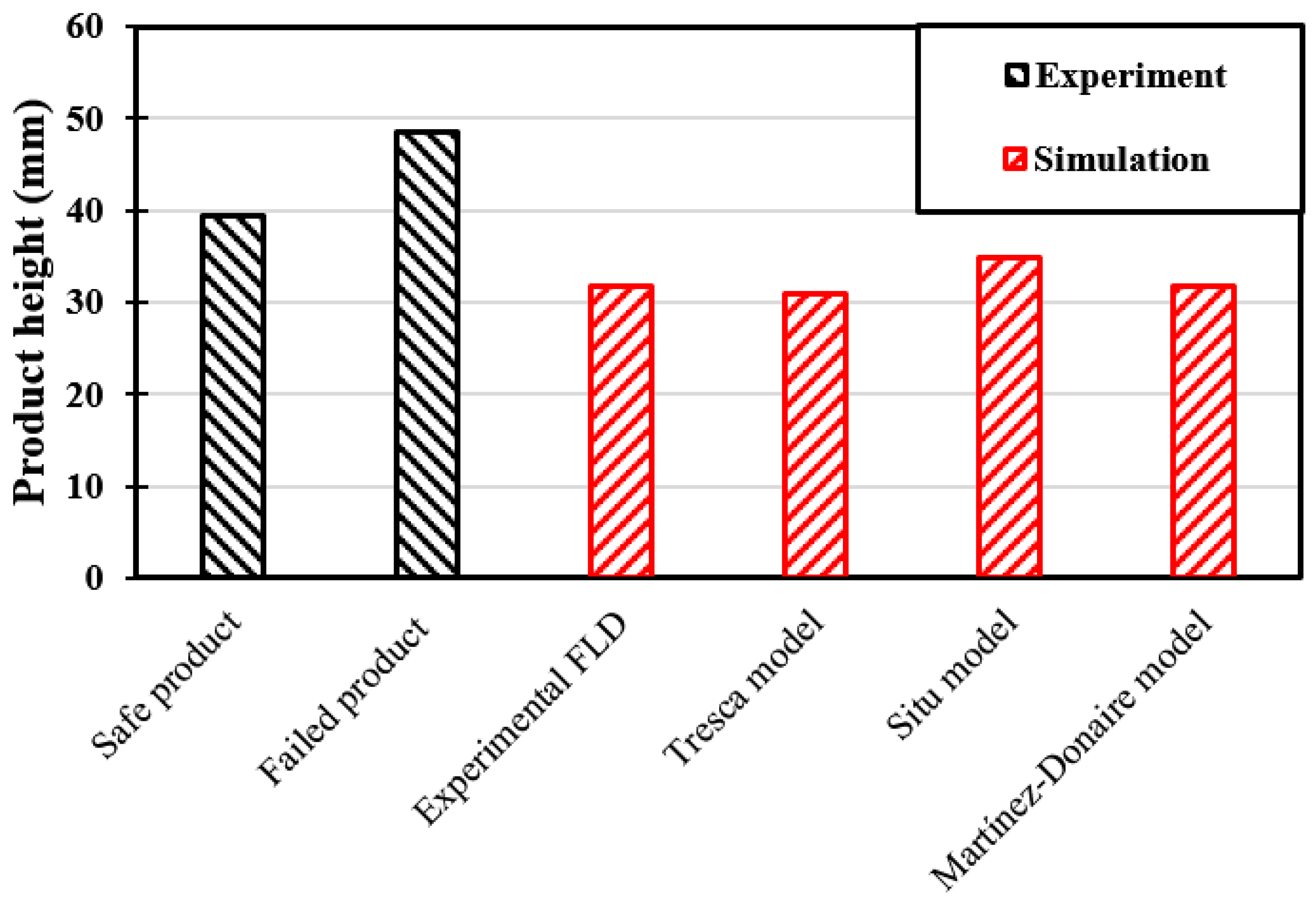
| C | Mn | Si | Al | N | P | S | V | Ti | Fe |
| 0.187 | 1.620 | 0.350 | 0.917 | >0.001 | 0.087 | 0.003 | 0.003 | 0.009 | Bal. |
| Criterion | Equation |
|---|---|
| Tresca [20] | (1) |
| Q. Situ et al. [21] | (2) |
| A.J. Martínez-Donaire et al. [23] | (3) |
| Simulation data | ||||||
| Friction coefficient | - | |||||
| blank-punch interface | 0.05 | |||||
| blank-matrix interface | 0.10 | |||||
| blank-holder interface | 0.10 | |||||
| Material data | ||||||
| Density (kg m−3) | 7800 | |||||
| Young’s modulus (GPa) | 210 | |||||
| Poisson ratio | 0.3 | |||||
| >Hardening law of the base material | >- | |||||
| >A | >B | >C | ||||
| >1099.98 | >520.90 | >6.27 | ||||
| >R11 | >R22 | >R33 | >R12 | >R23 | >R13 | |
| >1 | >1.0724 | >1.0076 | >1.0396 | >1 | >1 | |
| * , , , | ||||||
© 2018 by the authors. Licensee MDPI, Basel, Switzerland. This article is an open access article distributed under the terms and conditions of the Creative Commons Attribution (CC BY) license (http://creativecommons.org/licenses/by/4.0/).
Share and Cite
Habibi, N.; Sundararaghavan, V.; Prahl, U.; Ramazani, A. Experimental and Numerical Investigations into the Failure Mechanisms of TRIP700 Steel Sheets. Metals 2018, 8, 1073. https://doi.org/10.3390/met8121073
Habibi N, Sundararaghavan V, Prahl U, Ramazani A. Experimental and Numerical Investigations into the Failure Mechanisms of TRIP700 Steel Sheets. Metals. 2018; 8(12):1073. https://doi.org/10.3390/met8121073
Chicago/Turabian StyleHabibi, Niloufar, Veera Sundararaghavan, Ulrich Prahl, and Ali Ramazani. 2018. "Experimental and Numerical Investigations into the Failure Mechanisms of TRIP700 Steel Sheets" Metals 8, no. 12: 1073. https://doi.org/10.3390/met8121073






